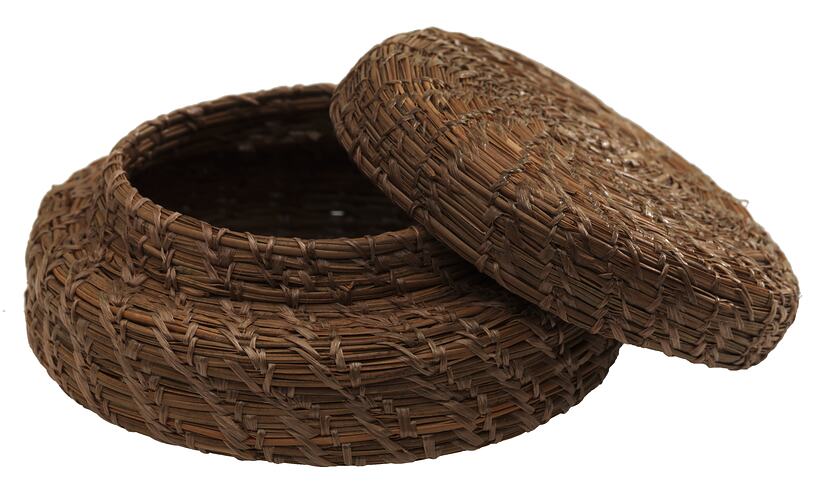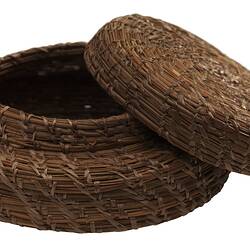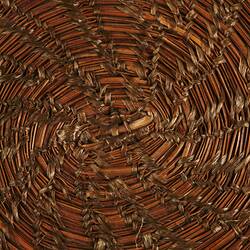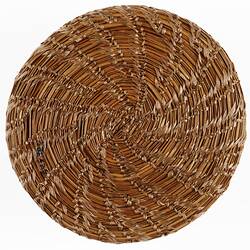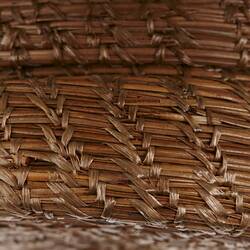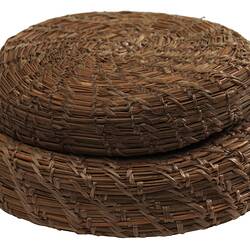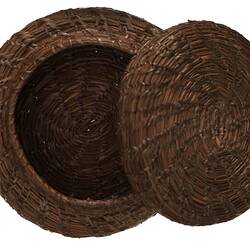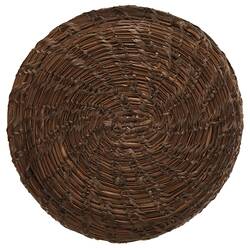Summary
Emma Karpany (1912-1988) was a Ngarrindjeri woman from Tatiara, in South Australia. She travelled north with her family and settled by the Murray River in Victoria in an attempt to prevent her children being taken by South Australian government officers. Using traditional practices, Emma (also known as Emily) would make koyi (baskets) and demonstrate weaving at town events to supplement the family income.
Her grandson, highly respected Elder Uncle David Tournier, speaks of Emma's weaving practice;
'I used to collect the pine needles for my grandmother Emma Karpany. She told me to only take the ones from the ground, where they fell under the tree. Several needles would be attached to a small nodule and these were the ones I picked up. Nan would pull them all apart to use for her baskets. When I asked her why I couldn't take them straight from the tree, she said you have to wait until the tree gives you the needles.' David Tournier 2013.
Ngarrindjeri women and children continue their weaving practice today. They have always harvested the natural fibres they use for weaving on their traditional lands from the edges of Lake Alexandrina. The women of the region have passed the knowledge of basket making from generation to generation, and they continue to use the same techniques, which encompass a range of different types of weaving to create baskets, nets and string bags.
Reeds are stripped and then dried. Some plant fibres are softened by chewing before the fibres are twined, and some plants are woven green.
Local Name
Koyi
Physical Description
Lidded coiled basket made from pine needles. With a circular base made using bundle-coil technique.
Significance
While many Ngarrindjeri women would weave with rushes and the long leaves of the Cumbungi, Emma worked primarily with pine needles. Using the long needles that would fall from old pine trees, she would make place mats and small baskets using the bundle-coil technique, a technique that had been used by Aboriginal women weavers from communities along the Murray and Yarra Rivers for thousands of years. Emma also worked with embroidery and created feather flowers, an art which she passed down to her daughter, Lettie Nicholls.
The collection and weaving process is communal on the shores of the lake. Like fishing, weaving has always been an opportunity to gather for storytelling. Ngarrindjeri Elder Aunty Ellen Trevorrow explains beautifully the multi-layered cultural teachings involved in contemporary inter-generational weaving practices;
'As a weaver I have to pick and dry the rushes, and when I go out for rushes I go with my children and sister children and friends. Through this sharing, teaching and learning, when they get to an age, they'll know. They're learning about the land, about the best places for rushes and how to pick them, about the different species, kukundo and pinkie, from the southeast, and marnggato from the Coorong'
Aunty Ellen Trevorrow, 1998.
References
Bell, D. 1998, Ngarrindjeri Wurruwarrin: a world that is, was, and will be p. 44, Spinifex Press.
More Information
-
Object/Medium
Basket
-
Maker
-
Locality
-
Date Produced
-
Object Measurements
100 mm (Length), 100 mm (Width), 45 mm (Height)
-
Classification
-
Date Made
-
Maker
-
Clan/Language Group
-
Place Made
-
Indigenous Region
-
Keywords
-
Type of item
-
Discipline
-
Category
-
Collecting Areas
